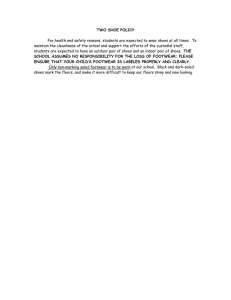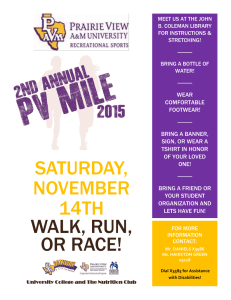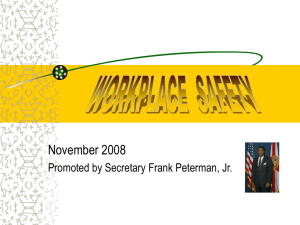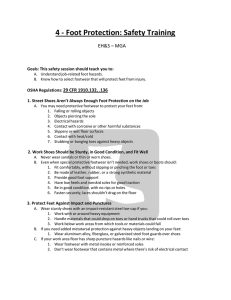Foot Wear Safety # 830 SECTION - Thunder Bay Catholic District
advertisement
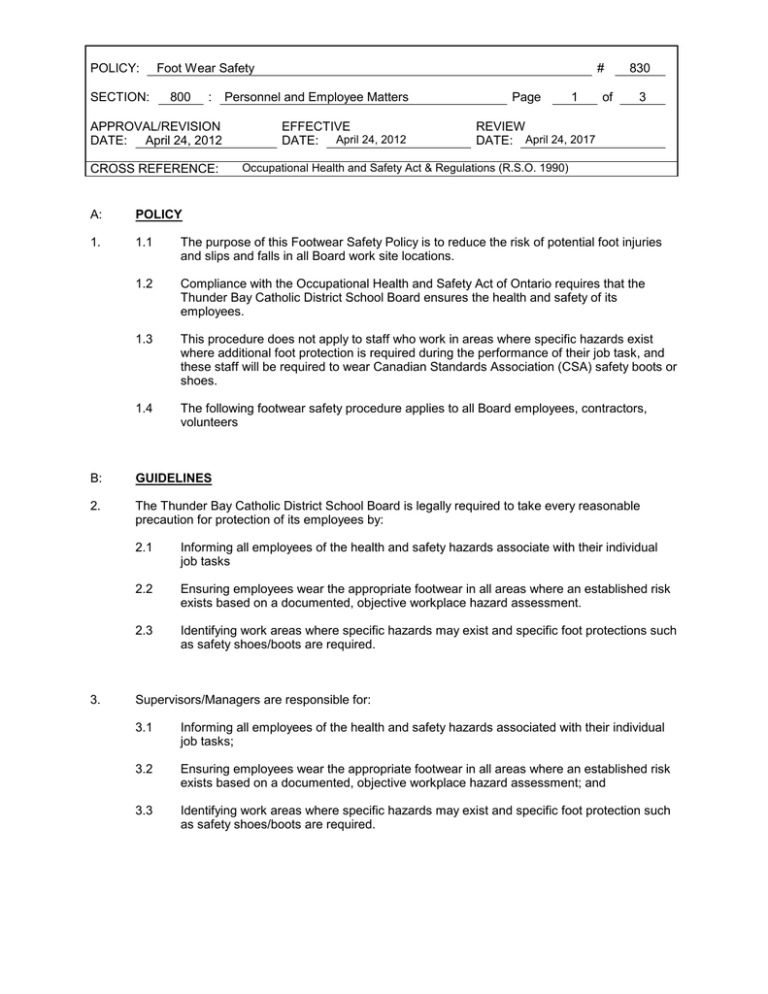
POLICY: SECTION: Foot Wear Safety 800 : APPROVAL/REVISION DATE: April 24, 2012 CROSS REFERENCE: # Personnel and Employee Matters EFFECTIVE DATE: April 24, 2012 Page 1 of 830 3 REVIEW DATE: April 24, 2017 Occupational Health and Safety Act & Regulations (R.S.O. 1990) A: POLICY 1. 1.1 The purpose of this Footwear Safety Policy is to reduce the risk of potential foot injuries and slips and falls in all Board work site locations. 1.2 Compliance with the Occupational Health and Safety Act of Ontario requires that the Thunder Bay Catholic District School Board ensures the health and safety of its employees. 1.3 This procedure does not apply to staff who work in areas where specific hazards exist where additional foot protection is required during the performance of their job task, and these staff will be required to wear Canadian Standards Association (CSA) safety boots or shoes. 1.4 The following footwear safety procedure applies to all Board employees, contractors, volunteers B: GUIDELINES 2. The Thunder Bay Catholic District School Board is legally required to take every reasonable precaution for protection of its employees by: 3. 2.1 Informing all employees of the health and safety hazards associate with their individual job tasks 2.2 Ensuring employees wear the appropriate footwear in all areas where an established risk exists based on a documented, objective workplace hazard assessment. 2.3 Identifying work areas where specific hazards may exist and specific foot protections such as safety shoes/boots are required. Supervisors/Managers are responsible for: 3.1 Informing all employees of the health and safety hazards associated with their individual job tasks; 3.2 Ensuring employees wear the appropriate footwear in all areas where an established risk exists based on a documented, objective workplace hazard assessment; and 3.3 Identifying work areas where specific hazards may exist and specific foot protection such as safety shoes/boots are required. POLICY: SECTION: Foot Wear Safety 800 : Personnel and Employee Matters APPROVAL/REVISION DATE: April 24, 2012 CROSS REFERENCE: 4. 5. EFFECTIVE DATE: April 24, 2012 Page 2 of 830 3 REVIEW DATE: April 24, 2017 Occupational Health and Safety Act & Regulations (R.S.O. 1990) Employees are responsible for: 4.1 All employees are required to wear safe and appropriate footwear that is in good condition at all times while in the workplace, keeping in mind their environmental hazards. 4.2 Reporting unsafe and unexpected surface and/or work conditions which may require maintenance, isolation or repair; and 4.3 Being aware of surrounding and conditions which would indicate the use of appropriate footwear and equipment. Factors Influencing Slips, Trips, Falls and Foot injuries 5.1 Slips, trips and falls can occur indoors on a variety of surfaces including: corridors, stairs and carpeted and tiled floors; and outdoors on sidewalks, stairs, playgrounds and parking lots. 5.2 Hazards that relate to slips, trips and falls exist whenever there is little friction and/or resistance between the sole of a shoe and the walking surface. A slip, trip or fall can cause a loss of balance and strain to regain balance or it may cause a fall and injury. The risks associated with slips, trips and falls can be influenced by factors such as: • • • • • • • • • 6. # Composition of the walking surface (floor coverings such as vinyl tiles, cement, carpeting, wood or gym surfaces); Obstructed views, poor lighting, clutter, uneven walking surfaces, unattended spills and/or debris and uncovered cables; Style and condition of shoe; Wearing inappropriate footwear for the task being performed. For example wearing an indoor shoe during yard duty. Presence of slippery material on the walking surface or on the shoe sole itself; Sudden or sharp changes in walking direction; and, Transitioning from a clean, dry surface to a wet, snowy or icy surface. Accessing ladders of all types including step stools, Rolling equipment such as wheel chairs, AV equipment or garbage containers Selecting Appropriate Footwear: 6.1 In order to determine the safe and appropriate footwear, each employee must understand the risks associated with the job and select footwear based on an understanding of the hazards within the individual job tasks, taking into account such factors as the conditions present in the work location, and weather conditions. 6.2 In addition, each employee will use his or her professional judgement in choosing footwear in keeping with the environment and the activities that are scheduled for that day including but not limited to: playgrounds, sports fields, gymnasiums, classrooms, science and technology labs, wet environments, walkways that have water, ice, sand, gravel or POLICY: SECTION: Foot Wear Safety 800 : # Personnel and Employee Matters APPROVAL/REVISION DATE: April 24, 2012 CROSS REFERENCE: EFFECTIVE DATE: April 24, 2012 Page 3 of 830 3 REVIEW DATE: April 24, 2017 Occupational Health and Safety Act & Regulations (R.S.O. 1990) snow covered, stairs, uneven walkways, sloping ground surfaces, loose ground surfaces, loose ground surfaces, activities that require lifting and elevated heights. 6.3 For the purpose of this procedure, the following guidelines are recommended for selecting safe and appropriate footwear. • • • • • Soft, synthetic rubber soles or neoprene soles are suitable for all surfaces, wet or dry, and for walking or standing on hard floor surfaces; Stable, slip resistant heel Hard, rubber soles grip on greasy concrete or wooden surfaces; and Totally enclosed shoes are recommended where an employee’s job could subject him or her to physical, chemical or work related hazards that could result in a foot related work injury. For example the Science and Technology Teachers, Custodians and Educational Assistants. Flip flops/beach shoes or loose fitting sandals/clogs are not appropriate at any time.
